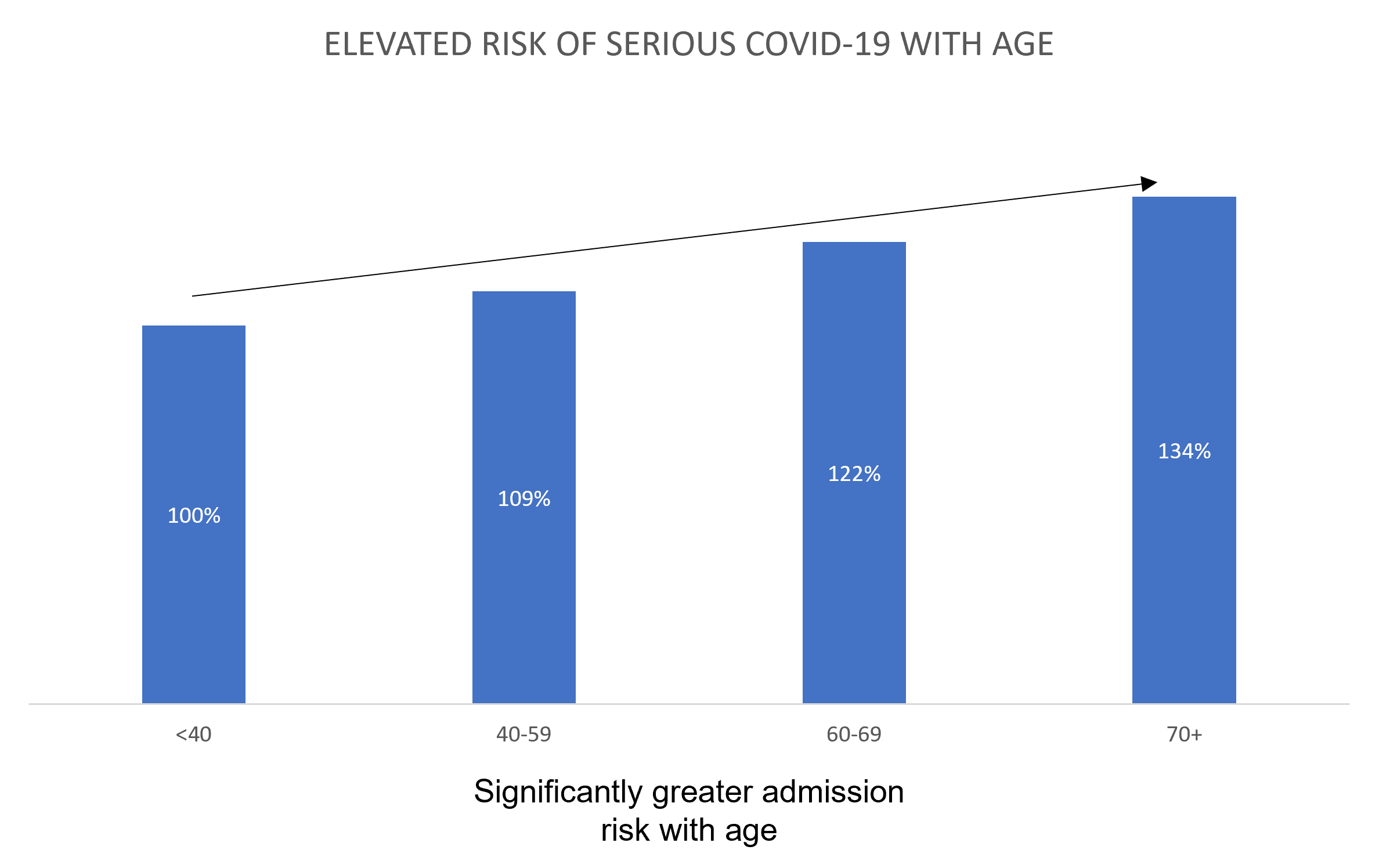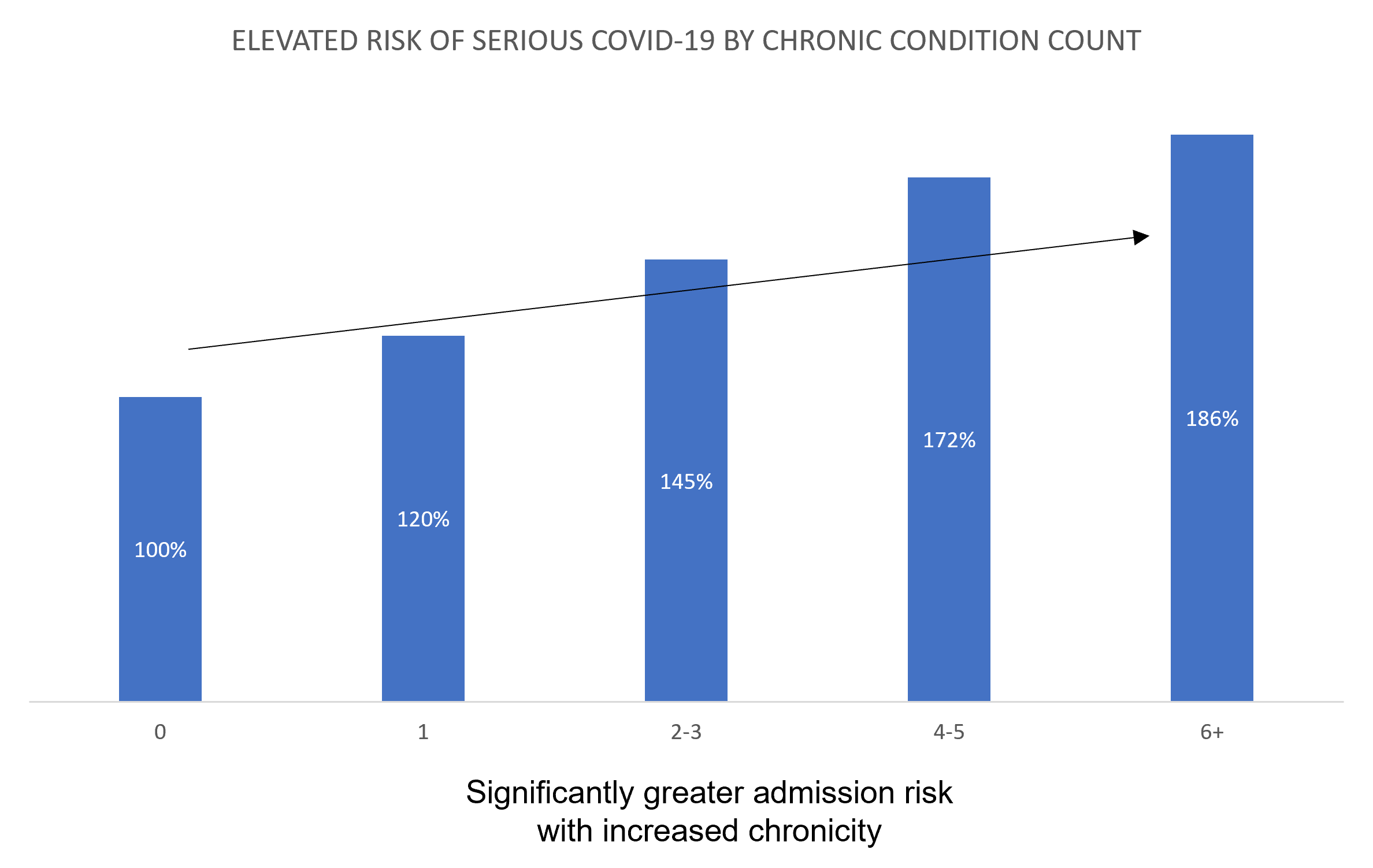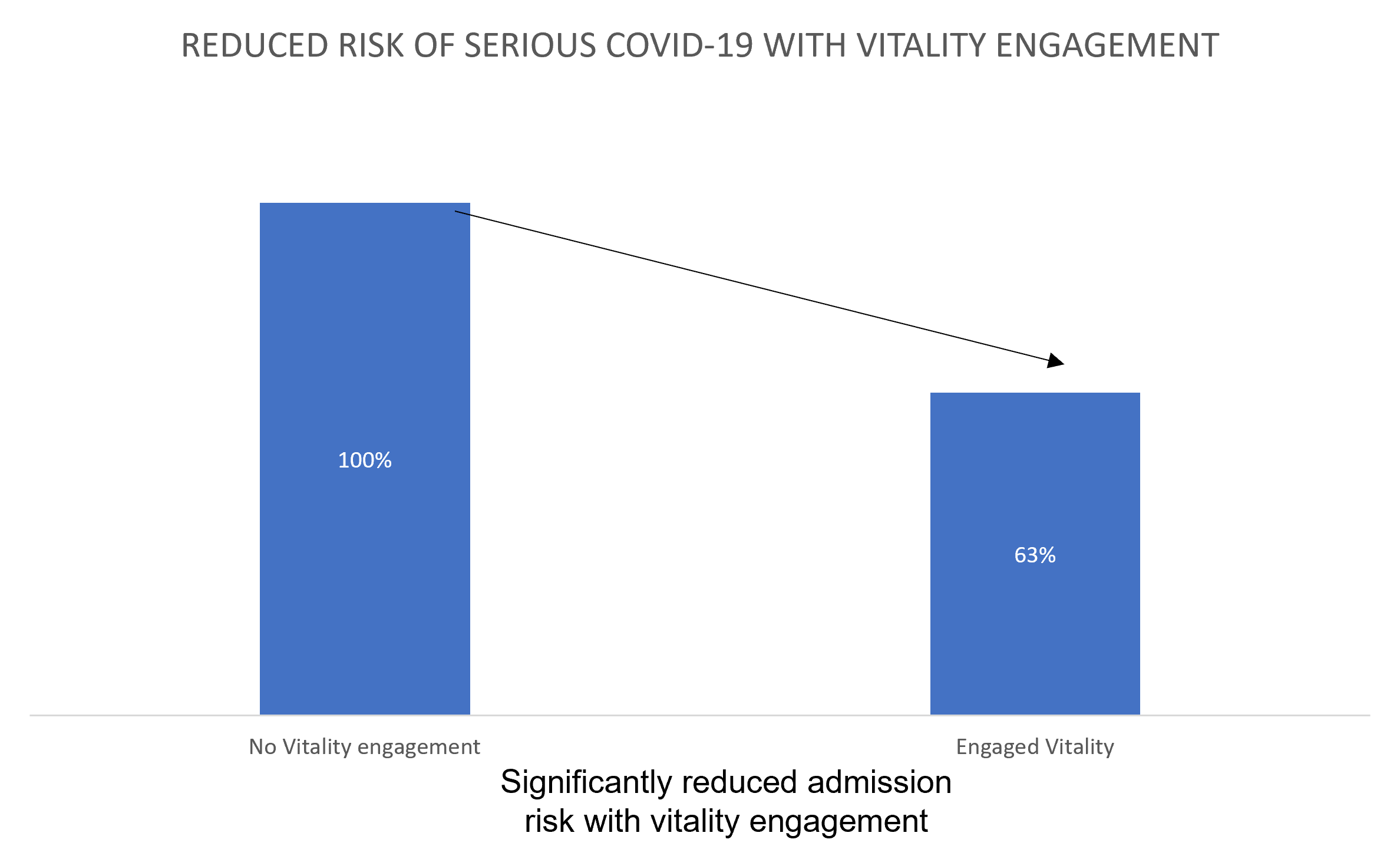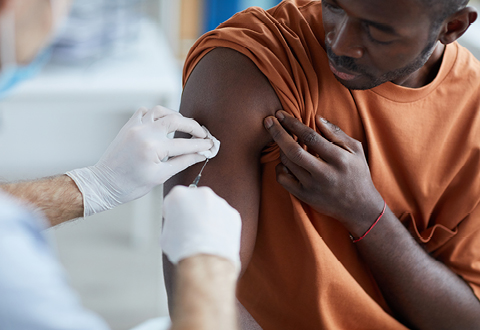Discovery's COVID-19 personal resilience index predicts an individual's resilience to serious COVID-19 illness

The older a person is and the more chronic conditions they have, the higher their risk of serious COVID-19 illness. Exercise is highly effective in lowering this risk. We combined these insights to create a COVID-19 personal resilience index, which is available to the public.
Authors
Lizelle Steenkamp (Senior Healthcare Statistician at Discovery Health), Tommy Chen (Actuary at Discovery Health), Jared Champion (Senior Actuary at Discovery Health) and Donald Ntjana (Senior Data Scientist at Discovery Health)
Identifying the top three predictors of serious COVID-19 illness
Our research shows that a person's age, the number of chronic illnesses they have and their levels of physical activity are strong predictors of their risk of serious COVID-19 outcomes.
Looking back to the early stages of the COVID-19 pandemic, Discovery data showed that people who exercised were at significantly less risk of going to hospital for, or dying from, COVID-19 than those who did not.
Discovery Vitality data shared in September 2020 showed that members of Vitality (Discovery's science-based wellness programme) who were engaged in the programme (regularly exercising) had a 37% lower risk of dying from COVID-19 (mortality risk) than members who weren't engaged.
COVID-19-related mortality risk decreased in line with their levels of engagement - so much so that, at the time, Vitality reported:
- The higher risk of serious COVID-19 illness linked to ageing could be offset by healthy living. A 65-year-old male with no chronic conditions who exercised for half an hour at least four times a week had the same mortality risk from COVID-19 as a 45-year-old who exercised once a week on average - and a 22% lower risk than a 45-year-old who did not exercise.
- Engagement in Vitality could also offset the higher COVID-19 risk linked to lifestyle-related chronic conditions. A 45-year-old male with hypertension who exercised four times a week (high engagement) had the same COVID-19 mortality risk as a 45-year-old male with no chronic conditions who did not engage in healthy behaviours.
Generally speaking, by following the healthy lifestyle behaviours (such as healthy eating, regular exercise, stress management and more) encouraged by the Discovery Vitality programme, Vitality members could lower their risk of serious COVID-19 illness.
Using these insights, we set out to create a 'COVID-19 personal resilience index' that would consider:
- A person's age
- The number of chronic conditions they have
- Their levels of physical activity.
We made this tool available to medical scheme members and members of the public so they could work out their resilience to serious COVID-19 outcomes.
Here, we explain the process of developing this tool.
How do age and number of chronic conditions affect the risk of serious COVID-19 illness?
By 5 April 2022, we had recorded the following information from members of medical schemes administered by Discovery Health:
- 591,445 confirmed cases of COVID-19
- 77,551 hospital admissions for COVID-19
- 15,390 deaths from COVID-19.
Leading clinical advisory organisations1,2 have also shared information, which shows that older people and those living with chronic conditions are at the highest risk of experiencing severe COVID-19 symptoms, which often lead to hospital admissions and death.
We also see these trends among members of Discovery Health-administered medical schemes. Our analysis of member data show that rates of COVID-19-related hospital admissions and death increase steeply, in line with both age (Figure 1a and b) and the number of chronic conditions members have (Figure 2a and 2b).

Figure 1a: The proportion of medical scheme members admitted to hospital for COVID-19, by age band
Figure 1b: The proportion of medical scheme members whose deaths were linked to COVID-19, by age band

Figure 2a: The proportion of medical scheme members admitted to hospital for COVID-19, in line with the number of chronic conditions they have (from no chronic conditions to more than five).
Figure 2b: The proportion of medical scheme members whose deaths were linked to COVID-19, in line with the number of chronic conditions they have (from no chronic conditions to more than five).
Developing a COVID-19 personal resilience index for scheme members and the public
- Discovery Health is South Africa's largest private health insurance administrator. We provide comprehensive healthcare insurance to more than 3.7 million people. Together, Discovery Health's data on health and mortality and Discovery Vitality's data on lifestyle and wellness covers 45 million life years. Life years refer to the number of years for which each individual contributes data to the pool. So, a person who is a member of Vitality for five years contributes five life years' worth of data to the pool.
- Access to this large pool of information allows our clinical research and actuarial teams to perform advanced disease-risk modelling for illnesses and diseases. With access to data on claims and how members use the private health system, we can generate real-world insights into the impact of COVID-19.
We combined Discovery Health's wealth of clinical and demographic data with the lifestyle data of scheme members who are also members of Vitality. Lifestyle data included logged exercise, nutrition patterns, mental health insights and healthy lifestyle indicators. With this information, we set out to:
- Find out which factors would put a member at the highest risk for severe COVID-19 outcomes.
For this part of the research, we used a statistical model and the US Centers for Disease Control and Prevention's (US CDC's) list of conditions associated with an increased risk of severe COVID-193. The US CDC classification describes people as being at a high risk for serious COVID-19 illness if they are over 60 years of age or if they have one or more a set of published chronic conditions (for example, lung or heart disease, diabetes or a condition that affects the immune system). - Create a COVID-19 personal resilience index.
Our goal in creating the index was to empower people with their own risk score so that they would be able to adopt protective lifestyle habits where possible, and give them a sense of the importance of reducing their exposure to COVID-19.
Applying the right statistical modelling
By November 2020, over 140,000 members of Discovery Health-administered medical schemes had contracted COVID-19.
We applied multiple analytical models to their data, including machine-learning algorithms such as Random Forest, Gradient Boosting Machine and an XGBoost.
The entire modelling dataset included:
- Any chronic conditions a member was registered for on their medical plan
- Demographic factors, such as age and sex
- Type of medical scheme plan a member was on
- The medicines a member had used
- Any procedures and consultations a member had undergone
- The types of healthcare providers a member had visited
- A member's Vitality data, with a focus on physical activity
From the statistical model, the three most notable factors with clear relationships to severe COVID-19 outcomes were age, chronic conditions, and engagement with Vitality - as shown in the graphs below.

Figure 3a shows elevated risk of serious COVID-19 outcomes with increasing age

Figure 3b shows elevated risk of serious COVID-19 outcomes with increasing chronicity

Figure 3c shows the reduction in risk of serious COVID-19 illness in line with Vitality engagement.
These factors combined build up to a person's resilience score.
We then used the model with the highest accuracy to make predictions of risk across the entire Discovery Health member base. These predictions were used to group members into five categories of resilience, ranging from 'very low' risk to 'very high' risk.
Assessing the US CDC's clinical risk classification guide
Using the CDC list of clinical conditions that affect the risk of severe COVID-19 outcomes, we categorised members as being at a 'high risk' of serious outcomes if they were over 60 years of age or if they had one of the chronic conditions on the CDC list.
Although useful, this form of clinical classification limited us to classifying members into two categories only: at 'high risk' or 'low risk'. This limited the overall level of detail in the risk categorisation.
Our aim was to create a single measure that used both the US CDC clinical classifications and the outputs of our statistical model.
Combining the US CDC clinical risk classification guide with Discovery Health's statistical models for optimal classification
We compared the five risk-prediction categories of our statistical modelling (from 'very high risk' to 'very low risk') to the US CDC categorisation ('high risk' or 'low risk') to see the overlap. The graph below (Figure 4) shows the results of this comparison.

Figure 4: The proportion of medical scheme members by resilience statistical model classification overlayed with the US CDC clinical classification.
Although the US CDC conditions were included as separate risk factors in our statistical model, there were some instances where the US CDC classification described members as 'high risk' for severe COVID-19 outcomes and our statistical model described them as 'very low' risk (1.4% of members, as shown in the graph above).
We therefore made an adjustment. If individuals had one of the US CDC risk factors and our statistical model flagged them as being at 'Average', 'Low or 'Very low' risk, we put them in a new 'High-average' risk category. This was done so they could be made aware they faced certain factors that increase their risk of severe COVID-19 outcomes.
This adjustment is shown in our final categorisations, below:

Figures 5: The proportion of medical scheme members by final risk score after the combined modelling approach.
Model verification and validation
To verify the modelling outputs, we looked at how many medical scheme members had been admitted to hospital for COVID-19 treatment in each of the categories.
As shown in the graph below, we found a linear downward trend. The highest hospital-admission rates were among people in the 'very high risk' category ("very low" resilience to serious COVID-19 outcomes as in the graph below - Figure 6) and the lowest hospital-admission rates were for those in the very low risk category ("very high" resilience to serious COVID-19 outcomes in the graph below).
This suggested that the model categories matched the lived experiences of medical scheme members.

Figure 6: The proportion of medical scheme members admitted to hospital for COVID-19 by final risk score (combined modelling approach with US CDC classification categories)
Know your own level of resilience to serious COVID-19 outcomes
The Discovery Health COVID-19 personal resilience index uses age, number of chronic conditions and levels of physical activity to work out an individual's risk of serious COVID-19 outcomes (or their resilience to these outcomes).
A 'High resilience' score means a person has a higher resilience to COVID-19 (or a lower risk of hospitalisation), than the average Discovery Health Medical Scheme member.
A 'Low resilience' score means one has a lower resilience to COVID-19 (or a higher risk of hospitalisation), than the average Discovery Health Medical Scheme member.
Knowing one's level of resilience to serious COVID-19 outcomes can help a person take action to increase their resilience, for example by:
- Increasing levels of physical activity
- Making plans with one's doctor around seeking care and knowing what to do if feeling very sick and in need of help at off-peak times for medical care
- Making sure one's COVID-19 and flu vaccinations are up to date
- Having enough stock of chronic or regular meds
- Limiting exposure to others and social events, especially during waves of COVID-19 infection
- Getting treatment early on for any COVID-19 symptoms.
It's also relevant to point out that these insights into the role of exercise in protecting against serious COVID-19 outcomes (one of the factors used to create the COVID-19 personal resilience index) were again confirmed in early 2022.
The British Journal of Sports Medicine published Discovery Health and Vitality's research article, "Small steps, strong shield: directly measured, moderate physical activity in 65,361 adults is associated with significant protective effects from severe COVID-19 outcomes." This research showed the remarkable protection that regular exercise (even at moderate levels) gives against serious COVID-19 illness.
Interested in knowing more or using these findings?
Please contact MEDIA_RELATIONS_TEAM@discovery.co.za for updated data and more information on the context of this analysis.
Did you find this post interesting?
- If you haven't yet, please read our related post which shares the exciting findings of a new Discovery Health and Vitality study published in the British Journal of Sports Medicine: "Small steps, strong shield: directly measured, moderate physical activity in 65,361 adults is associated with significant protective effects from severe COVID-19 outcomes". The study shares the incredible effects of exercise - whether at moderate or high levels - in preventing and protecting against serious COVID-19 outcomes.
- You may also find our post Diabetes and COVID-19: Poor blood-glucose control linked to serious COVID-19 outcomes interesting, as it reinforces the link between chronic illnesses and serious COVID-19 outcomes. Our research also proves the importance of having well-controlled blood-glucose levels and following a diabetes care programme to lower one's risk of serious outcomes.
All information shared on this page is based on perspectives gained from analysing figures and trends from Discovery Health's data pool. The analysis is conducted by Discovery Health's actuarial and data scientist team and aims to encourage industry dialogue. This content is shared for educational and informational purposes only. It is not peer-reviewed scientific research, so should not be used to make treatment decisions.
References
- Centers for Disease Control and Prevention, 30 Nov 2020: Assessing Risk Factors for Severe COVID-19 Illness
- Mayo Clinic, 1 Mar 2022: COVID-19: Who's at higher risk of serious symptoms ?
- Centers for Disease Control and Prevention, 2 May 2022. People with certain medical conditions (a list of conditions associated with increased risk of severe COVID-19)

New study published in British Journal of Sports Medicine: Exercise protects against serious COVID-19 outcomes
10 February 2022
Authors: Lizelle Steenkamp (Senior Healthcare Statistician at Discovery Health)

Discovery Health releases at-scale real-world analysis of Omicron outbreak; including collaboration with the SA Medical Research Council (SAMRC) to analyse vaccine effectiveness
14 December 2021
Discovery Health, South Africa's largest private health insurance administrator, releases at-scale real-world analysis of Omicron outbreak based on 211 000 COVID-19 test results in South Africa, including collaboration with the SA Medical Research Council (SAMRC) to analyse vaccine effectiveness.

Pfizer vaccine's real-world effectiveness in protecting against COVID-19 admission and death in the Discovery Health client population
03 November 2021
Authors: Shirley Collie (Chief Healthcare Analytics Actuary, Discovery Health) and Jared Champion (Senior Actuary, Discovery Health)